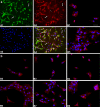Astroglial P2X7 receptor current density increased following long-term exposure to rotenone
- PMID: 21484098
- PMCID: PMC3083135
- DOI: 10.1007/s11302-011-9218-y
Astroglial P2X7 receptor current density increased following long-term exposure to rotenone
Abstract
The role of the interaction between neurons and glial cells in the pathogenesis of neurodegenerative diseases is gaining more attention. Neuroinflammation participates in the progressive nature of diverse neurologic diseases including Parkinson's disease, Alzheimer's disease and multiple sclerosis. Activated microglia release neurotoxic molecules, which take part in the neuroinflammatory responses. Astrocytes are also key players in these responses. Reactive astrocytes secrete inflammatory factors, including tumor necrosis factor-α (TNF-α). This secretion can be regulated by extracellular ATP mediated through P2X7 receptors. However, whether the activity of astrocytic P2X7 receptors changes in Parkinson's disease and whether these changes would influence the secretion of inflammatory factors in astrocytes are still unclear. In our study, through immunocytochemistry, whole-cell patch clamp and ELISA assay, we found that P2X7 receptors were expressed in midbrain astrocytes, and that, rotenone, a Parkinson's disease model used at a low concentration (2-20 nM) for 48 h increased the P2X7 receptor current density and thereby inhibited the secretion of TNF-α. Our research suggests that rotenone can regulate cytokine secretion of astrocytes through elevated P2X7 channel current density and, in turn, take part in the neuroinflammatory process in the rotenone Parkinson's disease model.
Figures




References
LinkOut - more resources
Full Text Sources

